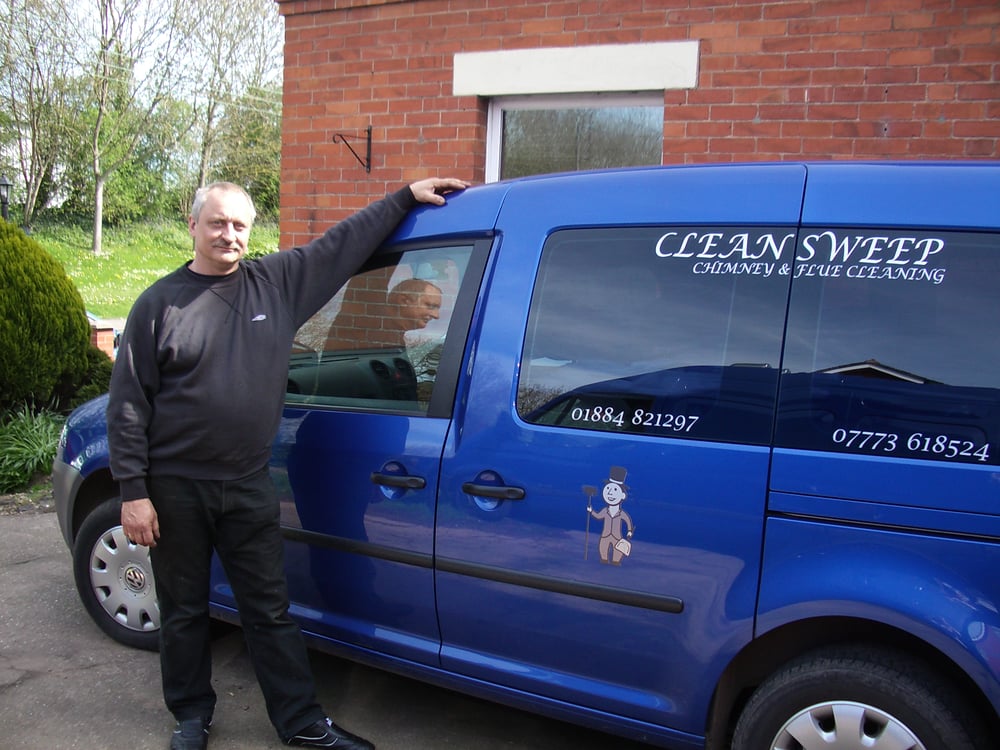My name is Kevin and I am an independant chimney sweep
I trained with an experienced sweep in 2006 and have been working as a chimney sweep ever since
I can clean virtually all domestic flues and Chimneys
My aim is to keep my customers safe and warm

Chimney and Flue cleaning for all domestic chimneys and flues for open fires, wood and multifuel stoves, pellet and woodchip boilers, AGA and Rayburn cookers Birds nests and blockages cleared
DANGER
CARBON MONOXIDE POISONING
Solid Fuel, Wood, Oil and Gas Appliances
Chimneys and Flues must be swept and checked regularly
Carbon Monoxide alarms available from DIY stores, Hardware stores and builders merchants, also online stores
OPEN FIRES
HAVE YOUR CHIMNEY CLEANED AT LEAST ONCE A YEAR (IF YOU USE HOUSECOAL TWICE A YEAR)
FIT A CARBON MONOXIDE ALARM
MAKE SURE YOU HAVE ENOUGH VENTILATION (DO NOT COVER VENTS)
USE THE BEST FUELS POSSIBLE TO MINIMISE CLOGGED FLUES (DO NOT BURN PLASTICS THEY GIVE OFF VERY TOXIC FUMES, CARRIER BAGS ARE A MAJOR CAUSE OF CHIMNEY FIRES (FLOATING UP THE CHIMNEY AS THEY BURN)
ALWAYS USE A FIREGUARD TO PREVENT STRAY SPARKS
WOODBURNERS
MAKE SURE THE FLUE IS CLEANED AT LEAST ONCE A YEAR
FIT A CARBON MONOXIDE ALARM
ONLY BURN SEASONED DRY WOOD (BELOW 20% MOISTURE CONTENT) OR SMOKELESS FUEL (DO NOT USE HOUSECOAL IT WILL BLOCK THE FLUE VERY QUICKLY AND CAN BURN TOO HOT CAUSING DAMAGE TO YOUR FIRE
WOODBURNERS AND MULTIFUEL STOVES ARE DESIGNED TO RUN AT ABOUT 350 C MAKE SURE YOUR STOVE GETS UP TO THIS TEMPERATURE OR YOU WILL TAR THE FLUE IF THE GLASS IN THE DOOR IS GETTING DIRTY OR GOING BLACK YOU ARE NOT RUNNING THE FIRE HOT ENOUGH , ALSO LETTING THE STOVE RUN SLOWLY OVERNIGHT IS A MAJOR CAUSE OF TAR AND IT IS VERY DIFFICULT SOMETIMES IMPOSSIBLE TO REMOVE
IF YOU ARE UNSURE OF THE TEMPERATURE YOU CAN PURCHASE A FLUE THERMOMETER WHICH IS MAGNETIC AND STICKS TO THE FLUE ABOVE THE STOVE
ALSO MOISTURE METERS ARE AVAILABLE TO CHECK YOUR WOOD
Make sure you are not at risk of CO poisoning
DO
Have your appliances installed and regularly checked and maintained for safety by a competent engineer
Empty ash from solid fuel appliances regularly, as the fire may not burn properly and damage may be caused to the appliance
Have chimneys and flues swept at least once a year even if you burn smokeless fuel, Coal fires require chimney cleaning more often
Have your chimneys and flues cleaned and checked after any prolonged period when appliance has not been in use
Clean appliance throat plate and flueways monthly, if in doubt refer to manufacturers instructions
Protect yourself
DO NOT
Use the wrong fuel for your appliance, for example green timber (less than 12 months old), incorrect size or grade of anthracite
Allow non competent people to install or maintain your appliance or sweep your chimney
Block or obstruct ventilation grilles or air bricks which provide fixed air paths
Cover an appliance or block air inlets, outlets or obstruct flues and chimneys
Use your appliance if you think it or its chimney is not working properly. Signs to look for are fumes or smoke in the house, slower
than usual burning, difficulty in lighting, evidence of sooting or staining around appliance and surrounding areas.
Particularly if suffering from symptoms mentioned above
The Danger
Heating and cooking appliances fuelled by coal, smokeless fuels, wood and oil can be just as likely as gas appliances to cause Carbon Monoxide (CO) poisoning if they are poorly installed, faulty or incorrectly used. CO poisoning is mostly caused by inadequate ventilation or lack of correct maintenance of appliances, flues and chimneys. Some incidents are also due to incorrect installation or deterioration of the structure of the chimney. Poisonous CO gas is produced when fuel does not burn properly. You can die from CO poisoning, or your health can be permanently damaged.
Be aware
CO gas has no smell, no colour and no taste, so you won’t know when it is present.
It can kill or maim without warning in a matter of hours. You are most vulnerable whilst sleeping. Children and the elderly are particularly at risk.
The early symptoms of CO poisoning include-tiredness, drowsiness, headache, dizziness, chest pains and nausea.
